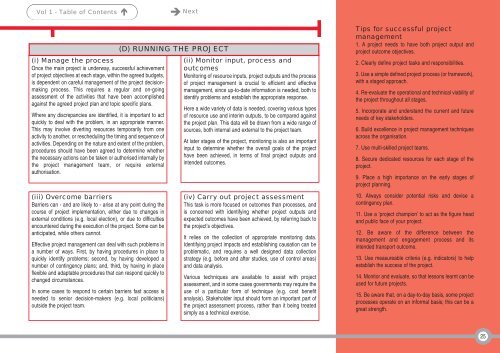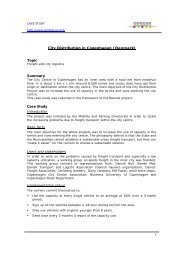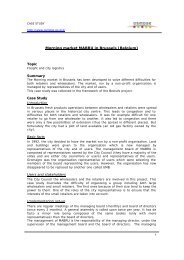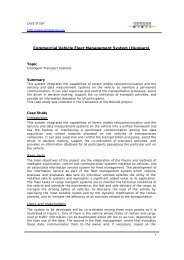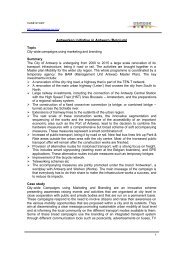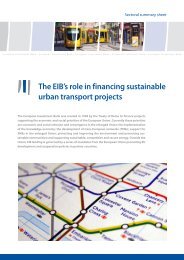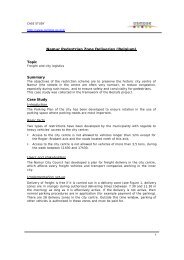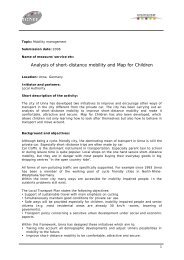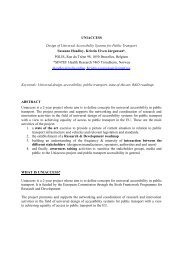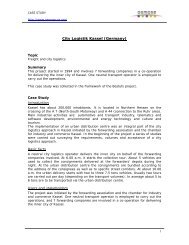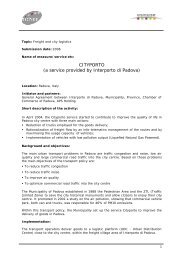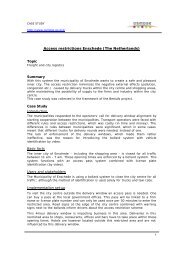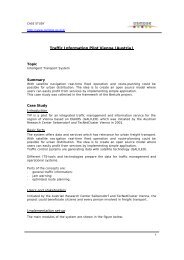Successful transport decision-making - Osmose
Successful transport decision-making - Osmose
Successful transport decision-making - Osmose
You also want an ePaper? Increase the reach of your titles
YUMPU automatically turns print PDFs into web optimized ePapers that Google loves.
Vol 1 - Table of Contents Next Tips for successful project<br />
(i) Manage the process<br />
Once the main project is underway, successful achievement<br />
of project objectives at each stage, within the agreed budgets,<br />
is dependent on careful management of the project <strong>decision</strong><strong>making</strong><br />
process. This requires a regular and on-going<br />
assessment of the activities that have been accomplished<br />
against the agreed project plan and topic specific plans.<br />
Where any discrepancies are identified, it is important to act<br />
quickly to deal with the problem, in an appropriate manner.<br />
This may involve diverting resources temporarily from one<br />
activity to another, or rescheduling the timing and sequence of<br />
activities. Depending on the nature and extent of the problem,<br />
procedures should have been agreed to determine whether<br />
the necessary actions can be taken or authorised internally by<br />
the project management team, or require external<br />
authorisation.<br />
(iii) Overcome barriers<br />
Barriers can - and are likely to - arise at any point during the<br />
course of project implementation, either due to changes in<br />
external conditions (e.g. local election), or due to difficulties<br />
encountered during the execution of the project. Some can be<br />
anticipated, while others cannot.<br />
Effective project management can deal with such problems in<br />
a number of ways. First, by having procedures in place to<br />
quickly identify problems; second, by having developed a<br />
number of contingency plans; and, third, by having in place<br />
flexible and adaptable procedures that can respond quickly to<br />
changed circumstances.<br />
In some cases to respond to certain barriers fast access is<br />
needed to senior <strong>decision</strong>-makers (e.g. local politicians)<br />
outside the project team.<br />
(D) RUNNING THE PROJECT<br />
(ii) Monitor input, process and<br />
outcomes<br />
Monitoring of resource inputs, project outputs and the process<br />
of project management is crucial to efficient and effective<br />
management, since up-to-date information is needed, both to<br />
identify problems and establish the appropriate response.<br />
Here a wide variety of data is needed, covering various types<br />
of resource use and interim outputs, to be compared against<br />
the project plan. This data will be drawn from a wide range of<br />
sources, both internal and external to the project team.<br />
At later stages of the project, monitoring is also an important<br />
input to determine whether the overall goals of the project<br />
have been achieved, in terms of final project outputs and<br />
intended outcomes.<br />
(iv) Carry out project assessment<br />
This task is more focused on outcomes than processes, and<br />
is concerned with identifying whether project outputs and<br />
expected outcomes have been achieved, by referring back to<br />
the project’s objectives.<br />
It relies on the collection of appropriate monitoring data.<br />
Identifying project impacts and establishing causation can be<br />
problematic, and requires a well designed data collection<br />
strategy (e.g. before and after studies, use of control areas)<br />
and data analysis.<br />
Various techniques are available to assist with project<br />
assessment, and in some cases governments may require the<br />
use of a particular form of technique (e.g. cost benefit<br />
analysis). Stakeholder input should form an important part of<br />
the project assessment process, rather than it being treated<br />
simply as a technical exercise.<br />
management<br />
1. A project needs to have both project output and<br />
project outcome objectives.<br />
2. Clearly define project tasks and responsibilities.<br />
3. Use a simple defined project process (or framework),<br />
with a staged approach.<br />
4. Re-evaluate the operational and technical viability of<br />
the project throughout all stages.<br />
5. Incorporate and understand the current and future<br />
needs of key stakeholders.<br />
6. Build excellence in project management techniques<br />
across the organisation.<br />
7. Use multi-skilled project teams.<br />
8. Secure dedicated resources for each stage of the<br />
project.<br />
9. Place a high importance on the early stages of<br />
project planning.<br />
10. Always consider potential risks and devise a<br />
contingency plan.<br />
11. Use a ‘project champion’ to act as the figure head<br />
and public face of your project.<br />
12. Be aware of the difference between the<br />
management and engagement process and its<br />
intended <strong>transport</strong> outcome.<br />
13. Use measureable criteria (e.g. indicators) to help<br />
establish the success of the project.<br />
14. Monitor and evaluate, so that lessons learnt can be<br />
used for future projects.<br />
15. Be aware that, on a day-to-day basis, some project<br />
processes operate on an informal basis; this can be a<br />
great strength.<br />
25


